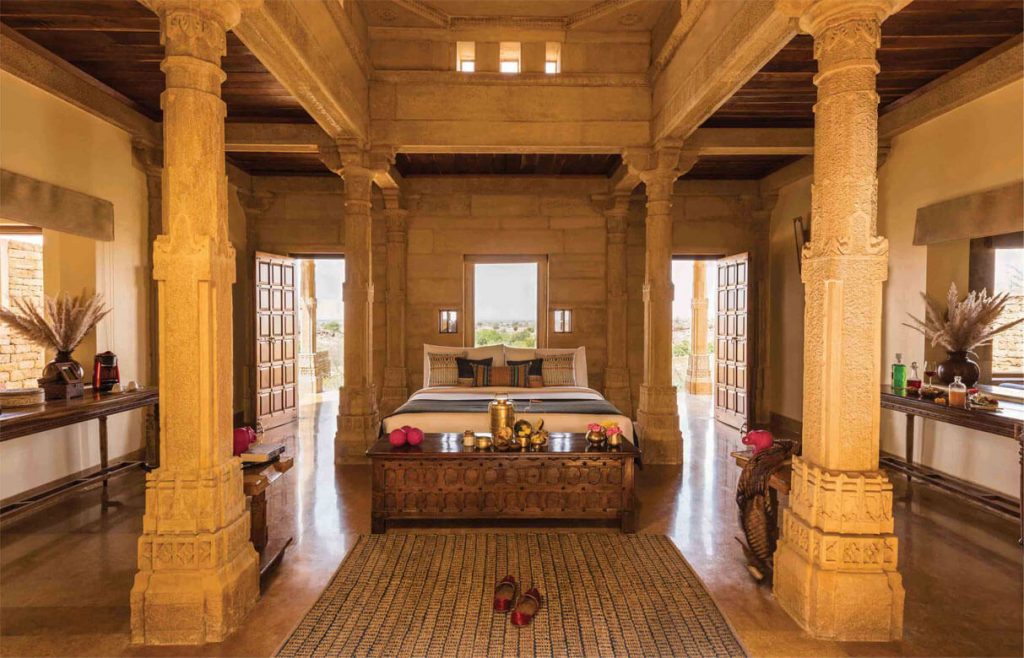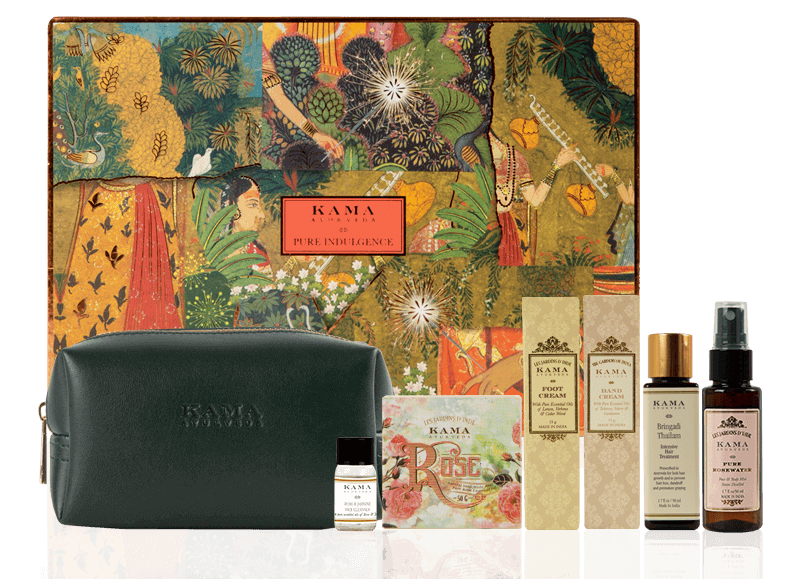Bespoke experiences that exemplify luxury and evoke a sense of charm, makes your stay at Suryagarh Jaisalmer seem like reliving the royal past.
As the sun turns a shade of burnished gold, the cavalcade of BMW, and the twin jeep outriders drive past the canons manning the large gates of the fortress-like structure and pull up at its courtyard. Like an orchestrated performance, the moustachioed man begins playing the drum, the cavalry on camel back stands up in attendance and the famed local Manganiyar singers break into a welcome song. Complementing every musical note with foot tapping dance moves are a row of colourfully-attired local Kalbeliadancers swirling their lithe frame and their long skirt in rhythmic symphony. Against the backdrop of the yellow sandstone edifice bathed in the last hue of sunlight, the courtyard pulsates with a vibrant energy as it hosts this grand show to herald our arrival. As if on cue, a shower of rose petals from the terrace takes us by surprise and heightens the crescendo, setting the tone for the next few days; of fine indulgences, bespoke experiences, heady moments and unforgettable memories.
Playing the host with absolute élan and flourish is Suryagarh, the luxury boutique resort situated nearly 15 kilometres away from the bustling city of Jaisalmer in Rajasthan. Beautifully encapsulating the essence of this ‘Golden City’, Suryagarh Jaisalmer is like poetry set in stone. Setting it leagues ahead from its counterparts is its emphasis on nuanced luxury and understated charm that resonates throughout the property; be it through its aesthetics, design, amenities, choice of artefacts, variety of culinary fare, well-trained staff, exceptional service, or its bespoke luxury experiences that it curates for its guests. It is the resort’s way of ensuring that every moment spent there remains etched into your memory for a lifetime.
“The hallmark of Suryagarh Jaisalmer is a belief in the extraordinary, as well as in excellence, comfort and consistency. Here in this quiet corner of the desert, history is the foundation; the experience is original and at every turn it offers its guests an ‘experience’ to catalogue and to curate. Whether it be a quest for retreat and quiet seclusion; soft spongy lawns underfoot in verdant hideaways and flower scented niches offering rare silence and solitude or, the excessive hedonism of a Silk Route Trail replete with fanfare and celebration, we create the perfect setting” says Karan Singh Vaid, president, MRS Hotels that owns the property.
LIVE LIFE KING-SIZE
Spread across 40 acres, Suryagarh takes you back in time. The massive fort-like structure has taken architectural cues from the adjoining forts and palaces and it can be seen across the property. One of its most expensive villas (Rs one lakh per night), the Thar Haveli evokes a sense of intimacy. Spread across 2,749 sq feet, these standalone suites, sensitively created around courtyards are far removed from the main building of the resort. Suryagarh Jaisalmer has four such haveli units and each of these connect traditional living with the more contemporary need for privacy and space. The Thar Haveli opens into two well-appointed spacious bedrooms on either side of a courtyard overlooking a private infinity pool and onto the wide sweeping vistas of the desert. There are colourful cushions and a low table laid out in the central courtyard for the family to unwind and soak in the beauty of the desert or to watch the millions of stars through the open ceiling on a moonlit night. A dining room, sitting area, terrace, massage room, bath tub and the presence of a personal butler service ensures that the four-member family gets absolute privacy within the confines. Luxury lies in the details and Suryagarh has mastered it to perfection. Every corner of this spacious property resonates with a sense of taste, superlative comforts, a touch of the indigenous desert culture while maintaining the start-of-the-art comfort, contemporary feel. It is a study in understated elegance.
The property boasts 75-rooms in various categories—Pavilion room, Fort room, Heritage room, Luxury Suite, Signature Suite, Jaisalmer Suite and Suryagarh Suite. Amenities in the resort include a gym, aptly called Akhara, Neel-the indoor pool, Rait-the spa, Draksh-the bar, Nosh, the all-day dining room and Legends of Marwar, the speciality restaurant bringing to your table the legendary fare of medieval hunts, court kitchens and the zealously guarded trade secrets of maharajahs’ kitchens. Raghavendra Rathore. Another striking part of the property is the presence of another fortress =like structure right behind. It is the staff housing quarters. Indeed a noteworthy gesture as it reflects how the hotel takes care of its employees and in return, they too embrace this place and its guests as if their own. In fact they exude genuine warmth and hospitality and go beyond the call of duty to make you feel at home.
SUBLIME DETOX
It’s the most relaxing 90 minutes that I had signed up for and Rait Spa, a name that immediately evokes images of the surrounding sand dunes (rait is the Indian name for sand), not only met my expectation but scored brownie points on several other counts — spacious therapy rooms, a couple’s massage room, plush ambience, four well-trained therapists and a wide range of wellness treatments–despite not being a spa resort. An early morning appointment at the spa was just what I needed to kick-start the day on a high energy note, considering the hectic activity that was lined up; a long drive to visit the ruins of an ancient civilisation.
Like those merchants selling healing potions in an Egyptian souk, spa manager Mahesh Kumar Raikwar introduced me to each of the glass jars kept in front of the table–rose, sandalwood, orange, ylang ylang and frankincense infused oils to choose from for the treatment. I opted for frankincense oil, having read about its age-old healing properties; a powerful astringent, known for preventing wrinkles, tightening the skinand slowing signs of ageing.
A precursor to the hour-and-a-half long signature Salt Massage is the 15-minute IMRS or Intelligent Magnetic Resonance Stimulation considered a healing spa massage for your mind. As you lie down with a headphone playing mild music and a pair of sunglasses with tricolour LEDs, the therapist does Reiki and the entire exercise is meant to open the blockages in your body’s bio-magnetic field, melt away stress, increase oxygenation in your brain, optimises mental balance and provides overall vitality.
Thereafter the Salt Massage session follows—cleansing of the feet, a deep tissue massage using the elbow technique with a generous slather of the frankincense oil, and a concentrated massage on key stress areas like the legs, shoulder and back. It is followed by a 15 minute rest on a bed covered with salt procured from the region’s adjoining Luni river, known for its therapeutic benefits. The primary benefits of the Salt Massage are meant to remove dead skin, open the pores, remove toxins, relax the stiff muscles and provide relief from joint aches. It not only makes you feel rejuvenated, a sense of lightness, complete relaxation of the body and mind but a visibly glowing skin too. A steam and shower later, I walk out to take on the long drive and hectic schedule with a spring in my step.
A FARE TO REMEMBER
The Legends of Marwar, the fine dining space at the central courtyard of the resort, opens its doors to a signature thali dinner that is not just a culinary journey to partake of the cuisine of Marwar region but an experience to savour. Bright red walls with sparkling glass chandeliers and fine cutlery greet you as the group of five make their way to the central table for an exclusive sit-down dinner with the entire hall reserved for the family and yours only. Sunil Paikaray, the assistant food and beverage manager who also doubles up as our personal butler during the stay, is not just a man who knows each one’s tastebuds and preferences in just half a day, he also cajoles you to try each course despite your appetite saying that’s it. Mumbai-based oenophile Sanjay Menon, a guest at the resort, makes a special appearance and takes us through the wines that would be uncorked for the evening. We begin with the dry Famille Hugel Alsace Riesling 2014 which is a fresh, lively and a fruity white wine that is low in alcohol and makes for an excellent aperitif. It pairs well with the seafood as well as the sauce-based and spicy dishes that are lined up for the evening. It is a sumptuous feast with a variety of vegetarian and non-vegetarian dishes local dishes served with a twist. For instance, the pyaaz aur pudine ke kebab is deep fried hung curd kebabs coated with sago coated and served with tomato and herbs extract. Or, the tulsi paneer tikka that comprises cottage cheese cubes marinated in basil paste and cooked in clay ovens. These are presented on a platter alongside a mini three-layered tiffin box comprising walnut chutney, garlic and ker (local green berry) pickle to pair with the kebab. For non-vegetarians, it was paired with Pathar Kutta Gosht or goat meat kebab hand pounded on stone with black cardamom and cinnamon flavour. Served in small portions, each dish was a build-up to the grand finale—Marwar thali that was brought in by the chef and his team in covered fabric only to be unveiled in unison amid a round of applause and ‘wows’. Chef Megh Singh introduced the thali that had the best of Marwar cuisine. Anjeer kofta curry, Jaisalmer Chatna Kadhi, dal bati churma were the highlights in the vegetarian platter whereas the Mohan maas and handi murgh were the show stealer in the non-vegetarian thali. The ruby-coloured Castello di Ama Chianti Classico 2013 with its high acidity, moderate alcohol, and grainy tannins created an affinity with tomato-based dishes and spicy meats. Ending the meal on a sweet note was the delectable badam ka halwa, khajoor ki rabri and kesar kasturi liquor.
A SUMPTUOUS REPAST
Build an appetite for an expansive halwai breakfast in the open courtyard where the traditional halwai from Jodhpur, chef Gatta Ram indulges you with the choicest Rajasthani fare ranging from the famous pyaaz ki kachori, fafda mirchi vada, fafda kadi, tamatar ka chaat to poori bhaaji, kesari lassi and jalebi dunked in pista milk. However, it is the wide range of freshly made sweets like gulkand barfi, mango barfi, kalakand, besan ki chakli and chamcham that is the highpoint and one that is much-raved about by both guests and locals alike. If you’re early for breakfast, you may get to eat with the peacocks who are a permanent guest at the hotel and strut around the courtyard at this hour.
“When everyone has sheets with high thread counts, personal butlers and other trappings you need to stand out, you need to be different,” says Singh. So, instead of the usual Continental or Indian breakfast taht is available at Nosh, Suryagarh also offers a special halwai breakfast for those keen on local delights.
Thereafter, the young and enterprising general manager Nakul Hada takes us on a desert trail, right into the heart of Thar desert to showcase its stunning geography, the vestiges of its historic past and the legends that dot this region. Endless stretches of the sandy desert with wild shrubs, jaal and khejri trees dotting its landscape are a constant companion during the Silk Route Exploration. These are interspersed in-between by khadeens, community farms and oasis where every nearby village has a share of the water and produce that is grown. Hada acquaints us with the irrigation system, the types of crops grown here and as we cross the Damodara and Dera villages, he mentions about the lifestyle, housing and occupation of these villagers, mostly stone carvers. The first stop on the trail is Khaba Fort, which stands at the intersection between Sindh and Jaisalmer along the Silk Route. It is believed to be 700 years old and was a pit stop for the merchants at night. It overlooks the ruins of a village, Kuldhara, once inhabited by the rich Paliwal brahmins. It was then suddenly deserted for mysterious reasons. The ruins of the homes of some 84 families that used to live here more than 200 years ago is still present. After a visit to the Devi Hinglai and Nabh Dungar temples, we take a break from the scorching heat in the comforts of an afternoon treat of sherbets and fruits in a white canopy especially set up by the hotel with staff in attendance even as twin camels have been kept close by for those wishing to experience the trail, just like the Silk Route merchants of yore. The resident Manganiyar singer has been driven down from the hotel to play the algoza (double flute instrument) to give a feel of the desert and familiarise us with its local music and lore.
After an exhaustive and enriching trail, it is time to return to the hotel well in time for a quick Mediterranean lunch followed by a sundowner near a sandy hillock, in a tranquil part of the desert, away from the hotel. A curated wine and cheese evening has been lined up for the group; canopies, mattresses, cushions, lanterns and a coal-fired grill. A Ca’del Bosco Franciacorta Cuvée Prestige Magnum served along with canapés, a variety of cheese, nuts and snacks even as you witness the myriad shades of the sandy desert during sun set and the quietness that envelope the landscape broken beautifully by the flute played by the Manganiyar singer even as you gaze at the starry sky above.
It is just the onset of a beautiful evening lined up back at the hotel where, as a homage to the culinary traditions of the travellers who crossed the Thar to Jaisalmer, a Thar dinner has been lined up at Celebration Gardens. It is the culmination of the entire day’s experience as part of the Silk Route Exploration. The Thar Dinner represents the end of this journey in a celebratory feast that is served to you in a communal setting. Starry skies, tasselled canopies and mattress style seating make this a most comfortable, enjoyable dining experience. With the singers and Kalbelia dancers uplifting the overall ambience, the able staff always around when you needed something but disappearing into the shadows to allow you privacy, you were left in an intimate set-up to enjoy the best of wines and the dinner that followed. After a round of starters and the accompanying wines, the thali was brought ceremoniously in a procession to the accompaniment of drums and fireworks exploding in the sky. A wholesome and delectable meal comprising pithod curry, ker kaju daakh, chandoi ki subzi, dum puloa and khamiri roti topped with naariyal boondi and mawa samosa was what made this a moment to savour forever.
DINNER ON THE DUNES
Setting off the day’s tour is the brunch set up near Jaziya Talao,-the reservoir that is used by the villagers and local herdsmen. An orange checkered parasol near the water body and the liveried staff in attendance welcomes you to soak in the rustic charm of the landscape and the oasis, a rarity in this region. With white mattresses, marigold flowers and Manganiyar musicians sitting under a babool tree, the setting is perfect for partaking in some Blood Mary, watermelon juice, dal pakwan, German potato slad, steamed bao wih spinach and cottage cheese patties kimchi salad, vegetable stew with buckwheat pilaf and banana caramel flan. Thereafter, the drive to the city landmarks include Lodrawa Jain temple dedicated to Lord Parshvanath the 23rd Jain tirthankara, Bada Bagh a garden complex that contains cenotaphs of the kings and queens, princes and other members of the royal family, and then to the legendary Jaisalmer Fort, the only living fort in the world and Patwon ki haveli, a cluster of five havelis or mansions of brocade merchants, some who still live here. A hectic day spent sight-seeing is complemented by an evening of absolute indulgence. A drive down to the Desert National Park in the evening with the car navigating down uneven road, halting at the occasional gazelle running past, leads us to a stretch of scrub land. A hotel’s staff standing with a lantern guides us through the darkness of the night to an uphill sand dune. Nothing prepares you for the sight that suddenly unfolds. Against the moonlit sky, you can see vast stretches of pristine sand dunes {beyond access to the layman}, with a bonfire lit up right at the centre of a pit and a group of folk singers and dancers sitting atop a distant plateau. They break into mellifluous as soon as we reach the top of the dune. It is most magical setting–canopies, mattresses with cushions, tables, live grill counter and lanterns lighting up the space to present the beauty of the desert, absolutely unfiltered. In a true representation of a nomadic hunt menu, the menu comprises khargosh masala {hare roasted on wood fire}, jungle maas, murge ka mokul, tawa bater for non-vegetarians. For vegetarians, there is bhutta badaam kebab, sangria kebab and followed by the main course comprising an assortment of locally-grown vegetables, pearl millet bread, pulao and lauki halwa and anjeer barfi. As you lie down on a set-up bed and soak in the unmatched view of the starry sky and the moonlight bathing the sand dunes in glistening silver, the soulful music and the lingering lyrics, Padharo Mhaare Desh {welcome to my village} beckons you to return to this magical land one more time.




